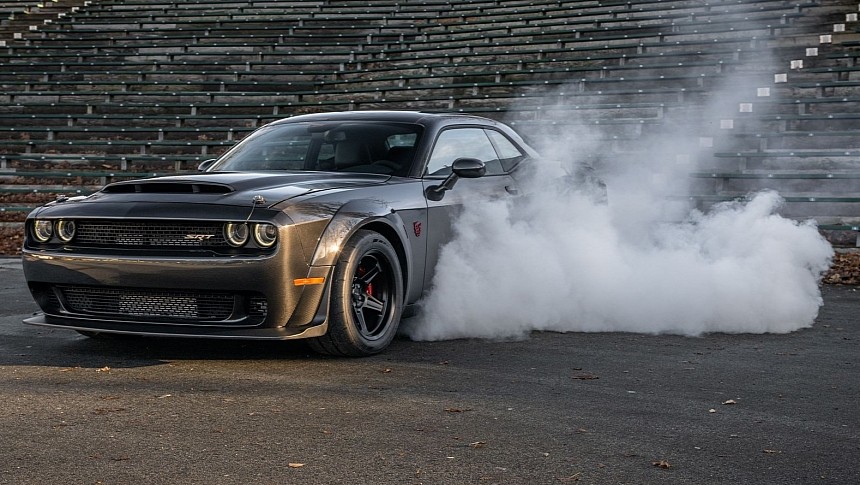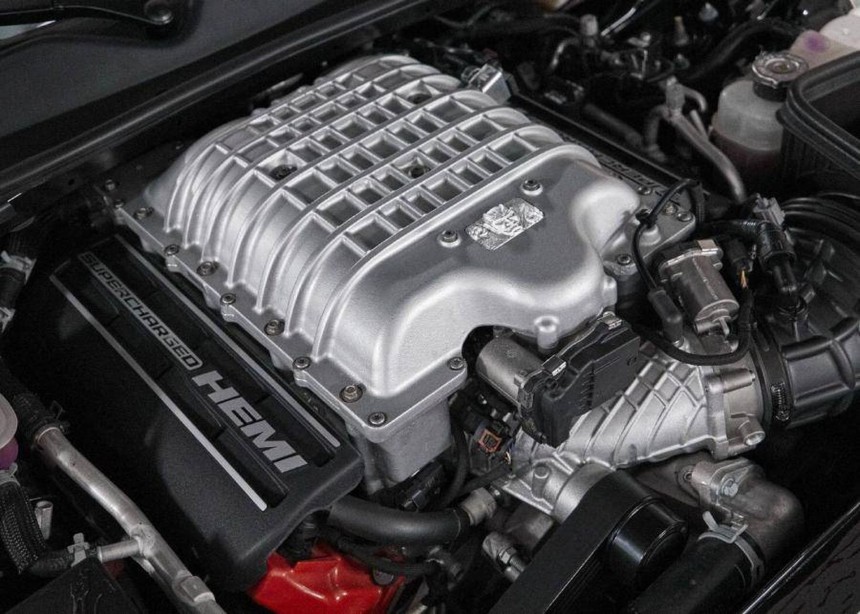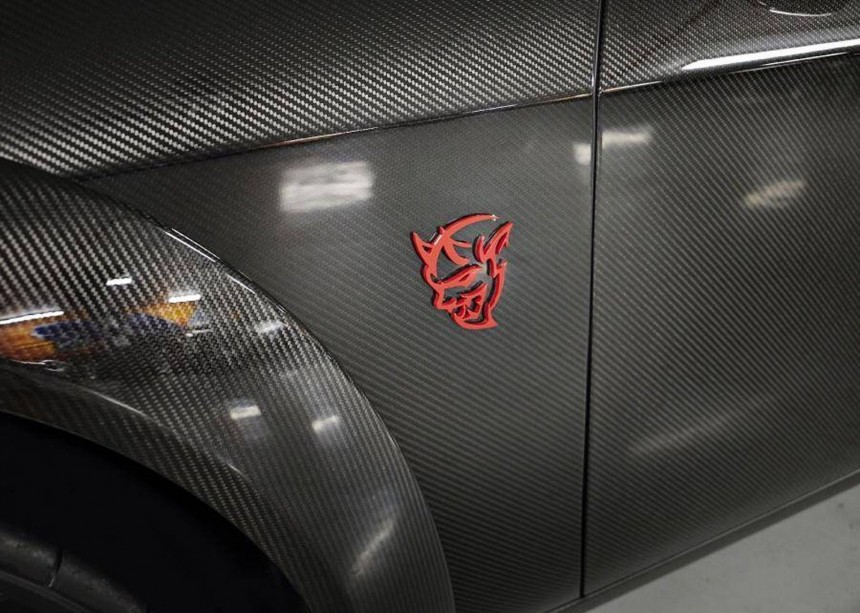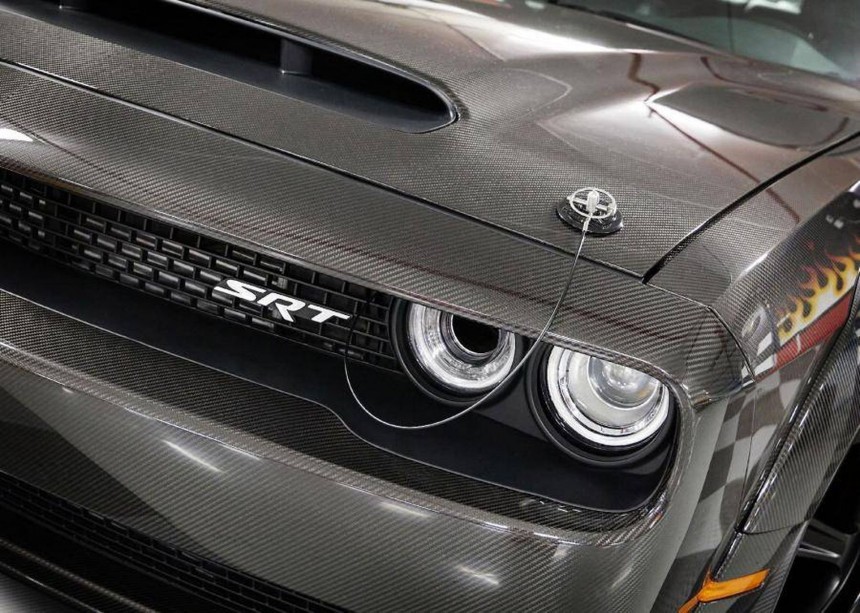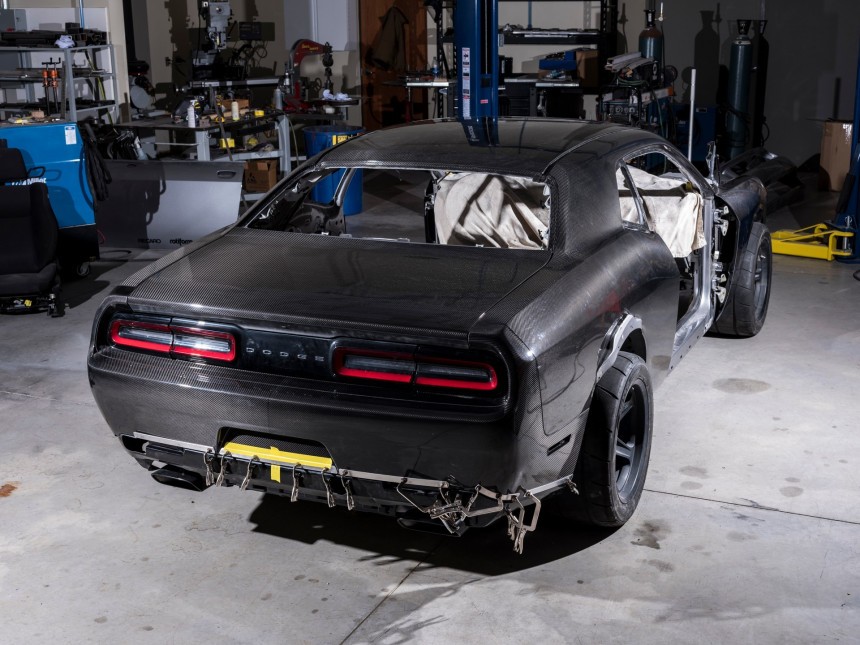One of the five 2018 Dodge Challenger Demons modified by SpeedKore with carbon fiber bodies is offered for sale. It is the only one the speed shop left the supercharger in (albeit increasing the output by 220 hp and over 300 lb-ft), and it was used to craft the moldings for the following four carbon-ified Demons.
When the Dodge Demon came out in 2018, its specs sheet was so haw-droppingly awesome that nobody raised a hand and asked, ‘Isn’t it a bit too heavy?’ With 808 hp and 717 lb-ft to the rear wheels, weight wasn’t precisely the first attribute that would pop up on a die-hard car nut’s list of ‘to delete.’
And yet, somebody addressed this detail, made a lighter Demon, and added just a fairy wing’s worth of sprinkle of extra horsepower. Translated into car talk, it’s 220 hp over stock. And 200 lbs. lighter, thanks to carbon fiber body panels. Want one? Dig deeper in your pockets ‘cause this is the only one, and it’s a lot of money.
Here's the deal: the Challenger SRT Demon set foot (hoof) on Planet Piston six years ago, and it shook heaven and earth with its wheelie-popping ability. Factory-rated at 808 hp (820 PS) and 717 lb-ft of transmission-torturing torque (972 Nm), the supercharged 6.2-liter HEMI was no joke. But that wasn’t all: if fed with high-grade 100-octane gas and fitted with a Direct Connection Controller, the hellish V8 would grace the driver with 840 hp (852 PS) and 770 lb-ft (1,044 Nm).
However, a certain speed shop from Grafton, Wisconsin – for the sake of unholy speed, let’s call it SpeedKore Performance Group because that’s its name – decided that a regular Demon was too down to earth. So, without too much fuss, the tuners took one, stripped all sheet metal from it, fabricated carbon fiber replacements, and voila, the Demon just lost 200 lbs (90 kg).
It doesn’t sound like much, but that was only the beginning. SpeedKore also fiddled with the engine’s internals and somehow managed to extort 1,028 ponies from the massive HEMI. Torque numbers were even more impressive: 1,049 lb-ft (1,416 Nm). The satanic performance was attained by fitting stronger conrods and pistons, upgrading the cooling system, tweaking the valvetrain, and slapping a dual-stage fuel pump to the block.
Now, let’s recap the essentials: a Dodge Demon HEMI wasn’t exactly a soccer mom’s idea of a powerplant for a grocery-getter, to begin with. The heads were machined on a dedicated CNC that only worked on Demon parts. To reduce bore distortion to a bare minimum, the block was deck plate honed. I should add that, before shipping to the assembly plant, each Demon V8 got a 42-minute dyno testing session running at 5,200 RPM.
Let’s put the things in elementary school levels of understanding. Every power stroke puts a force equivalent to 11 tons on every piston and connecting rod. It’s like stacking five 2018 Dodge SRT Challenger Demons on top of each other and carefully balancing all their combined masses on a piston. At 6,300 RPM, this nice little antic would repeat every 20 milliseconds (or 50 times a second).
Every minute, 1.36 gallons (5.15 liters) of high-octane fuel is required to obtain the aforementioned power rating. The heat generated from exploding all that gasoline would be enough to boil a liter of water at room temperature in 1.2 seconds. Cool? Quite the opposite (take that literally, obviously).
The SRT Power Chiller uses the cabin air conditioning system to cool down the intake air by 18°F (10°C). Speaking of air, the motor would require 173 cubic feet of it to complete a standing quarter run. That’s 4.9 cubic meters in about 9 seconds – thanks to a 2.7-liter, 14.5 PSI (one Bar) supercharger. To put it in perspective: the same amount would be enough to fill the lungs of 816 average adult human beings.
And since we are talking dragstrip numbers, how about another one: 11,164 lb-ft is the torque exerted on the ring gear at launch, putting 1.8 Gs on the driver and overloading the rear wheels with 2,500 lbs. (one full ton).
And yet, somehow, that wasn’t enough for SpeedKore, who took one SRT Demon and used it as a test mule for their Challenger Widebody carbon fiber add-ons. The body panels were formed using carbon fiber fabric pre-impregnated with epoxy resin, then molded and cured in the tuner’s in-house autoclave.
SpeedKore made two types of composite components for this Demon: bolt-on panels and bonded panels. The hood, the rear deck lid, and the rear spoiler are among the former category and use the fasteners and mounting locations as the original metal parts.
The bonded panels are quarter panels, rockers, door skins, or the roof, and they attach to the body using the same spot weld locations as the sheet metal ones. Additionally, the carbon fixtures receive a perimeter bead of panel adhesive (see the gallery for a quick overview of the process).
After using the car at shows as a demonstrator, SpeedKore sold it in March 2020 for $160,000, when it had around 200 miles (320 km) on the clock. Four years later, the same Demon – with 1,000 miles on the clock (1,600 metric clicks) – asks $207,000. Does it sound like a more appealing alternative to the Demon 170?
And yet, somebody addressed this detail, made a lighter Demon, and added just a fairy wing’s worth of sprinkle of extra horsepower. Translated into car talk, it’s 220 hp over stock. And 200 lbs. lighter, thanks to carbon fiber body panels. Want one? Dig deeper in your pockets ‘cause this is the only one, and it’s a lot of money.
Here's the deal: the Challenger SRT Demon set foot (hoof) on Planet Piston six years ago, and it shook heaven and earth with its wheelie-popping ability. Factory-rated at 808 hp (820 PS) and 717 lb-ft of transmission-torturing torque (972 Nm), the supercharged 6.2-liter HEMI was no joke. But that wasn’t all: if fed with high-grade 100-octane gas and fitted with a Direct Connection Controller, the hellish V8 would grace the driver with 840 hp (852 PS) and 770 lb-ft (1,044 Nm).
It doesn’t sound like much, but that was only the beginning. SpeedKore also fiddled with the engine’s internals and somehow managed to extort 1,028 ponies from the massive HEMI. Torque numbers were even more impressive: 1,049 lb-ft (1,416 Nm). The satanic performance was attained by fitting stronger conrods and pistons, upgrading the cooling system, tweaking the valvetrain, and slapping a dual-stage fuel pump to the block.
Now, let’s recap the essentials: a Dodge Demon HEMI wasn’t exactly a soccer mom’s idea of a powerplant for a grocery-getter, to begin with. The heads were machined on a dedicated CNC that only worked on Demon parts. To reduce bore distortion to a bare minimum, the block was deck plate honed. I should add that, before shipping to the assembly plant, each Demon V8 got a 42-minute dyno testing session running at 5,200 RPM.
Every minute, 1.36 gallons (5.15 liters) of high-octane fuel is required to obtain the aforementioned power rating. The heat generated from exploding all that gasoline would be enough to boil a liter of water at room temperature in 1.2 seconds. Cool? Quite the opposite (take that literally, obviously).
The SRT Power Chiller uses the cabin air conditioning system to cool down the intake air by 18°F (10°C). Speaking of air, the motor would require 173 cubic feet of it to complete a standing quarter run. That’s 4.9 cubic meters in about 9 seconds – thanks to a 2.7-liter, 14.5 PSI (one Bar) supercharger. To put it in perspective: the same amount would be enough to fill the lungs of 816 average adult human beings.
And yet, somehow, that wasn’t enough for SpeedKore, who took one SRT Demon and used it as a test mule for their Challenger Widebody carbon fiber add-ons. The body panels were formed using carbon fiber fabric pre-impregnated with epoxy resin, then molded and cured in the tuner’s in-house autoclave.
SpeedKore made two types of composite components for this Demon: bolt-on panels and bonded panels. The hood, the rear deck lid, and the rear spoiler are among the former category and use the fasteners and mounting locations as the original metal parts.
After using the car at shows as a demonstrator, SpeedKore sold it in March 2020 for $160,000, when it had around 200 miles (320 km) on the clock. Four years later, the same Demon – with 1,000 miles on the clock (1,600 metric clicks) – asks $207,000. Does it sound like a more appealing alternative to the Demon 170?
